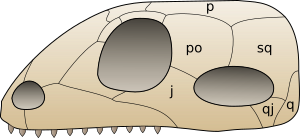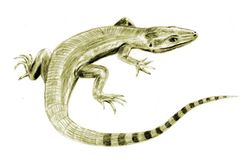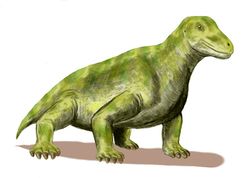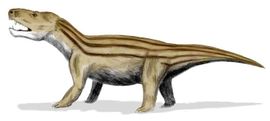مندمجات الأقواس
| Synapsids | |
|---|---|
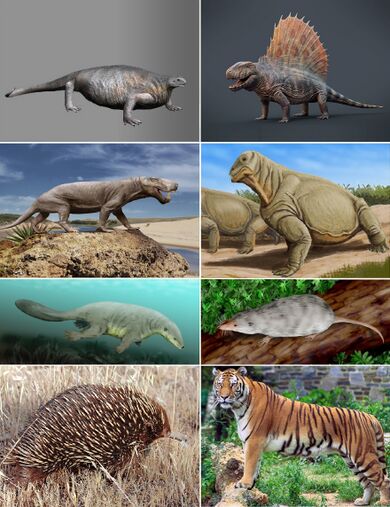
| |
| Examples of synapsids (left to right, top to bottom): Cotylorhynchus, Dimetrodon, Inostrancevia, Moschops, Castorocauda, Adelobasileus, Tachyglossus aculeatus, and Panthera tigris | |
| التصنيف العلمي | |
| أصنوفة غير معروفة (أصلحها): | الحياة |
| مملكة: | الحيوانية |
| Phylum: | حبليات |
| Superclass: | فقاريات_رباعية_الأطراف |
| Clade: | أشكال_الزواحف |
| Clade: | سلويات |
| الفرع الحيوي: | مندمجات الأقواس Osborn, 1903 |
| Subgroups | |
| Synonyms | |
مندمجات الأقواس أو ملتحمات الأقواس (الاسم العلمي: Synapsid) [أ] هي أصنوفة عليا من الحيوانات تفرعت من السلويات وتفرعت منها الثدييات والحيوانات القريبة منها.[6] يفرق بينها والسلويات الأخرى بأن لمندمجات الأقواس ثقوبا في الجمجمة خلف العينين .[7] مندمجات الأقواس البدائية تسمى بليكوصورات، وأما مندمجات الأقواس المتقدمة فهي تشبه الثدييات وتسمى ثيرابسيدا. مندمجات الأقواس التي لا تنتمي للثدييات تسمى زواحف مشابهة للثدييات.[8][9][10]
نشأت مندمجات الأقواس من السلويات الأصلية (حيوانات يكون جنينها في كيس سلى) إذ تنقسم السلويات إلى مجموعتين كبيرتين هما مندمجات الأقواس التي تشمل الثدييات والزواحف التي تشمل السلاحف والحرشفيات والتمساحيات والطيور والعظاءات المنقرضة أمثال التيرانوصور. تكونت مندمجات الأقواس الأولية ذات ثقوب في الجمجمة قبل نحو 324 مليون سنة خلال الحقبة المتأخرة من العصر الكربوني (البنسلفاني).
كانت مندمجات الأقواس هي الحيوانات السائدة على اليابسة من رباعيات الأطراف خلال الحقبة بين 299 إلى 250 مليون سنة. وانقرض معظمها مع الحيوانات التي انقرضت الاخري خلال انقراض العصر البرمي الترياسي. ولكن بعض منها عاش خلال العصر الثلاثي (ترياسي)، واصبحت الأركوصورات أكبر الفقاريات العائشة على اليابسة في ذلك العصر. وقليل من مندمجات الأقواس التي ليست من الثدييات استمر العيش حتى العصر الطباشيري.
تفرع منها الثدييات وبذلك لا تزال مندمجات الأقواس على قيد الحياة حتى وقتنا هذا. وبعد انقراض العصر الطباشيري-الثلاثي قبل نحو 65 مليون سنة أصبحت مندمجات الأقواس ممثلةً في الثدييات أكثر الحيوانات التي تعيش على اليابسة. كل ما تبقى من مندمجات الأقواس حتى الآن هي الثدييات, ومنها الأنسان.
During the Triassic, the sauropsid archosaurs became some of the largest and most numerous land vertebrates, only rivaled in size by kannemeyeriiform dicynodonts, and gave rise to the dinosaurs. When all non-avian dinosaurs were wiped out by the Cretaceous–Paleogene extinction event, the mammalian synapsids diversified again to become the largest land and marine animals on Earth.
. . . . . . . . . . . . . . . . . . . . . . . . . . . . . . . . . . . . . . . . . . . . . . . . . . . . . . . . . . . . . . . . . . . . . . . . . . . . . . . . . . . . . . . . . . . . . . . . . . . . . . . . . . . . . . . . . . . . . . . . . . . . . . . . . . . . . . . . . . . . . . . . . . . . . . . . . . . . . . . . . . . . . . . .
التصنيف الليناوي والشجري
At the turn of the 20th century synapsids were thought to be one of the four main subclasses of reptiles. However, this notion was disproved upon closer inspection of skeletal remains, as synapsids are differentiated from reptiles by their distinctive temporal openings. These openings in the skull bones allowed the attachment of larger jaw muscles, hence a more efficient bite.
Synapsids were subsequently considered to be a later reptilian lineage that became mammals by gradually evolving increasingly mammalian features, hence the name "mammal-like reptiles" (also known as pelycosaurs). These became the traditional terms for all Paleozoic (early) synapsids. More recent studies have debunked this notion as well, and reptiles are now classified within Sauropsida (sauropsids), the sister group to synapsids, thus making synapsids their own taxonomic group.[8][9]
As a result, the paraphyletic terms "mammal-like reptile" and "pelycosaur" are seen as outdated and disfavored in technical literature, and the term stem mammal (or sometimes protomammal or paramammal) is used instead. Phylogenetically, it is now understood that synapsids comprise an independent branch of the tree of life.[11] The monophyly of Synapsida is not in doubt, and the expressions such as "Synapsida contains the mammals" and "synapsids gave rise to the mammals" both express the same phylogenetic hypothesis. This terminology reflects the modern cladistical approach to animal relationships, according to which the only valid groups are those that include all of the descendants of a common ancestor: these are known as monophyletic groups, or clades.
Additionally, Reptilia (reptiles) has been revised into a monophyletic group and is considered entirely distinct from Synapsida, falling within Sauropsida, the sister group of Synapsida within Amniota.[12]
البدائية والمتقدمة
The synapsids are traditionally divided for convenience, into therapsids, an advanced group of synapsids and the branch within which mammals evolved, and stem mammals, (previously known as pelycosaurs), comprising the other six more primitive families of synapsids.[13] Stem mammals were all rather lizard-like, with sprawling gait and possibly horny scutes, while therapsids tended to have a more erect pose and possibly hair, at least in some forms. In traditional taxonomy, the Synapsida encompasses two distinct grades: the low-slung stem mammals have given rise to the more erect therapsids, who in their turn have given rise to the mammals. In traditional vertebrate classification, the stem mammals and therapsids were both considered orders of the subclass Synapsida.[7][8]
الاستخدام العملي مقابل التطوري لـ"مندمجات الأقواس" و"وحشيات الأوجه"
In phylogenetic nomenclature, the terms are used somewhat differently, as the daughter clades are included. Most papers published during the 21st century have treated "Pelycosaur" as an informal grouping of primitive members. Therapsida has remained in use as a clade containing both the traditional therapsid families and mammals.
Although Synapsida and Therapsida includes modern mammals, in practical usage, those two terms are used almost exclusively when referring to the more basal members that lie outside of Mammaliaformes.
السمات
الفتحات الصدغية
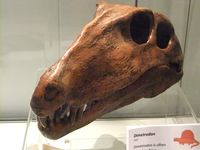
يعود تسمية مجموعة مندمجات الأقواس إلى تقب الجمجمة الذي يحيطه العظام : "جوجال" J و "كوادراتوجوجال" qJ و "سكاموسوم" sq و "بوست أوربيتال" po (انظر الشكل). ويوجد الكوادرتوجوجال بهذا الحجم في البليكوصورات الأصلية، ويوجد صغيرا في البليكوصورات العليا، وتغطي عظمة السكاموسوم الجزء الخلفي للفتحة بالكامل.
الأسنان
تلك الفتحة في الجمجمة أتاحت الفرصة لتكوّن عضلات قوية للفك ، وقللت في نفس الوقت من وزن الجمجمة. وصغرت الفتحة في السينابسيدات التي جاءت بعد ذلك (الثيرابسيدات العليا والثدييات) وتطورت بحيث أصبحت غير واضحة.
كان شكل مندمجات الأقواس الأصلية (بليكوصور) مقارب لشكل الزواحف وربما عاشت بطريقة الزواحف. وأما أنواعها العليا (ثيرابسيدا) فتغير فيها التمثيل الغذائي ليكون سريعا وبذلك أصبح لجسمها درجة حرارة ثابتة، وحلق ثانوي يتيح لها فرصة التنفس والأكل في نفس الوقت. علاوة على ذلك تزودت للثيرابسيدا بغدد أكثر، وأصبحت بعض أجسامها مغطاة بشعر وتنوعت الأسنان فيها من قطعية وأنياب وضروس.
كما تغير وضع أجسامها : فبينما كان للزواحف أطرافا مفرودة جانبيا فكانت زاحفة ، فقد تطورت الأطراف في مندمجات الأقواس العليا (ثيرابسيدا) ابتداء من أواسط العصر البرمي قبل نحو 270 مليون سنة لتكون تحت الجسم تحمله وترفعه عن الأرض. بذلك أصبحت سريعة الحركة ويمكنها المداومة على الحركة.
الفك
كان الفك السفلي لمندمجات الأقواس المبكرة (بليكوصور) يتكون من عدة عظام مترابطة منها واحدة تحمل الاسنان. وتطورت العطمة الحاملة للأسنان الأسنان مع الوقت وزاد عددها وصغرت العظام الاخرى حتى أصبح الفك السفلي لدي الثدييات كاملا من عظمة واحدة.
أحد العظام التي تخلفت عن الفك والذي يسمى Articulare تطور في الثدييات ليكوّن أحد عظام الأذن (المطرقة) وهي في الأذن الداخلية.
الحلق
Over time, as synapsids became more mammalian and less 'reptilian', they began to develop a secondary palate, separating the mouth and nasal cavity. In early synapsids, a secondary palate began to form on the sides of the maxilla, still leaving the mouth and nostril connected.
Eventually, the two sides of the palate began to curve together, forming a U shape instead of a C shape. The palate also began to extend back toward the throat, securing the entire mouth and creating a full palatine bone. The maxilla is also closed completely. In fossils of one of the first eutheriodonts, the beginnings of a palate are clearly visible. The later Thrinaxodon has a full and completely closed palate, forming a clear progression.[14]
الجلد والفراء
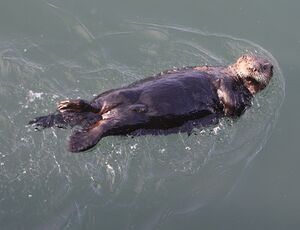
In addition to the glandular skin covered in fur found in most modern mammals, modern and extinct synapsids possess a variety of modified skin coverings, including osteoderms (bony armor embedded in the skin), scutes (protective structures of the dermis often with a horny covering), hair or fur, and scale-like structures (often formed from modified hair, as in pangolins and some rodents). While the skin of reptiles is rather thin, that of mammals has a thick dermal layer.[15]
The ancestral skin type of synapsids has been subject to discussion. Among the early synapsids, only two species of small varanopids have been found to possess osteoderms;[16] fossilized rows of osteoderms indicate bony armour on the neck and back. However, some recent studies have cast doubt on the placement of Varanopidae in Synapsida,[17][18] while others have countered and lean towards this traditional placement.[19][20] Skin impressions indicate some early synapsids basal possessed rectangular scutes on their undersides and tails.[21][22] The pelycosaur scutes probably were nonoverlapping dermal structures with a horny overlay, like those found in modern crocodiles and turtles. These differed in structure from the scales of lizards and snakes, which are an epidermal feature (like mammalian hair or avian feathers).[23] Recently, skin impressions from the genus Ascendonanus suggest that at least varanopsids developed scales similar to those of squamates.[24]
It is currently unknown exactly when mammalian characteristics such as body hair and mammary glands first appeared, as the fossils only rarely provide direct evidence for soft tissues. An exceptionally well-preserved skull of Estemmenosuchus, a therapsid from the Upper Permian, preserves smooth skin with what appear to be glandular depressions,[25] an animal noted as being semi-aquatic.[26] The oldest known fossil showing unambiguous imprints of hair is the Callovian (late middle Jurassic) Castorocauda and several contemporary haramiyidans, both non-mammalian mammaliaform[27][28] (see below, however). More primitive members of the Cynodontia are also hypothesized to have had fur or a fur-like covering based on their inferred warm-blooded metabolism.[29] While more direct evidence of fur in early cynodonts has been proposed in the form of small pits on the snout possibly associated with whiskers, such pits are also found in some reptiles that lack whiskers.[29] There is evidence that some other non-mammalian cynodonts more basal than Castorocauda, such as Morganucodon, had Harderian glands, which are associated with the grooming and maintenance of fur. The apparent absence of these glands in non-mammaliaformes may suggest that fur did not originate until that point in synapsid evolution.[29] It is possible that fur and associated features of true warm-bloodedness did not appear until some synapsids became extremely small and nocturnal, necessitating a higher metabolism.[29] The oldest examples of nocturnality in synapsids is believed to have been in species that lived more than 300 million years ago.[30]
However, Permian coprolites from Russia showcase that at least some synapsids did already have fur in this epoch. These are the oldest impressions of hair on synapsids.[31]
. . . . . . . . . . . . . . . . . . . . . . . . . . . . . . . . . . . . . . . . . . . . . . . . . . . . . . . . . . . . . . . . . . . . . . . . . . . . . . . . . . . . . . . . . . . . . . . . . . . . . . . . . . . . . . . . . . . . . . . . . . . . . . . . . . . . . . . . . . . . . . . . . . . . . . . . . . . . . . . . . . . . . . . .
الغدد الثديية
Early synapsids, as far back as their known evolutionary debut in the Late Carboniferous period,[32] may have laid parchment-shelled (leathery) eggs,[33] which lacked a calcified layer, as most modern reptiles and monotremes do. This may also explain why there is no fossil evidence for synapsid eggs to date.[34] Because they were vulnerable to desiccation, secretions from apocrine-like glands may have helped keep the eggs moist.[32]
According to Oftedal, early synapsids may have buried the eggs into moisture laden soil, hydrating them with contact with the moist skin, or may have carried them in a moist pouch, similar to that of monotremes (echidnas carry their eggs and offspring via a temporary pouch[35][36]), though this would limit the mobility of the parent. The latter may have been the primitive form of egg care in synapsids rather than simply burying the eggs, and the constraint on the parent's mobility would have been solved by having the eggs "parked" in nests during foraging or other activities and periodically be hydrated, allowing higher clutch sizes than could fit inside a pouch (or pouches) at once, and large eggs, which would be cumbersome to carry in a pouch, would be easier to care for. The basis of Oftedal's speculation is the fact that many species of anurans can carry eggs or tadpoles attached to the skin, or embedded within cutaneous "pouches" and how most salamanders curl around their eggs to keep them moist, both groups also having glandular skin.[34]
The glands involved in this mechanism would later evolve into true mammary glands with multiple modes of secretion in association with hair follicles. Comparative analyses of the evolutionary origin of milk constituents support a scenario in which the secretions from these glands evolved into a complex, nutrient-rich milk long before true mammals arose (with some of the constituents possibly predating the split between the synapsid and sauropsid lines). Cynodonts were almost certainly able to produce this, which allowed a progressive decline of yolk mass and thus egg size, resulting in increasingly altricial hatchlings as milk became the primary source of nutrition, which is all evidenced by the small body size, the presence of epipubic bones, and limited tooth replacement in advanced cynodonts, as well as in mammaliaforms.[32][33]
الغشاء الجناحي
Aerial locomotion first began in non-mammalian haramiyidan cynodonts, with Arboroharamiya, Xianshou, Maiopatagium and Vilevolodon bearing exquisitely preserved, fur-covered wing membranes that stretch across the limbs and tail. Their fingers are elongated, similar to those of bats and colugos and likely sharing similar roles both as wing supports and to hang on tree branches.[37]
Within true mammals, aerial locomotion first occurs in volaticotherian eutriconodonts. A fossil Volaticotherium has an exquisitely preserved furry patagium with delicate wrinkles and that is very extensive, "sandwiching" the poorly preserved hands and feet and extending to the base of the tail.[38] Argentoconodon, a close relative, shares a similar femur adapted for flight stresses, indicating a similar lifestyle.[39]
Therian mammals would only achieve powered flight and gliding long after these early aeronauts became extinct, with the earliest-known gliding metatherians and bats evolving in the Paleocene.[40]
تاريخ تطورها
 مقالة مفصلة: تطور الثدييات
مقالة مفصلة: تطور الثدييات
أوائل مندمجات الأقواس كانت Archaeothyris و Clepsydrops [41] وعاشت خلال البنسلفاني (الحقبة المتأخرة من العصر الكربوني) بين 299 - 323 مليون سنة سبقت , وتعتبر منتمية إلى السينابسيدات البدائية المسماة بليكوصور. وانتشرت البليكوصورات وتنوعت خلال العصر الكربوني المتأخر حتى اصبحت الحيوانات السائدة على اليابسة.
واستمرت حتى العصر البرمي المبكر ، واصبح منها ما يصل طوله إلى نحو 6 أمتار. كانت منبطحة على الارض ثقيلة الجسم من ذوات الدم البارد. وكان لبعضها مثل "ديمتريدون" شراع كبير على ظهرها ، ربما كانت وظيفته تنظيم درجة حرارة جسمها . ومع قدوم أواخر العصر البرمي انقرضت معظم البليكوصورات أو تطورت إلى ما خلفها من ثيرابسيدات.[42] تتطورت الثيرابسيدات بعد ذلك وظهرت منها الثدييات.
ظهرت الثيرابسيدات وهي المجموعة المتطورة من مندمجات الأقواس خلال أواسط العصر البرمي وشملت أكبر حيوانات اليابسة خلال البرمي الأوسط و البرمي المتأخر. شملت تلك الحيوانات آكلات النباتات و آكلات اللحوم ، وكان منها صغير الجسم في حجم الفأر (مثل "روبرتيا") ومنها الكبير آكل الأعشاب ما يزن طنا أو أكثر (مثل "الموسشوب") . وبعد ازدهارها عبر عدة ملايين السنين حدث انقراض العصر البرمي الترياسي قبل نحو 250 مليون سنة فانقرض معظمها ، وهذا كان أكبر انقراض في تاريخ الأرض ، وربما كان سببه النشاط البركاني الكبير في سيبيريا المسمى مصاطب سيبيريا ، انتشرت فيه صهارة بركانية بازالتية بشكل كبير في شمال سيبيريا.
عبرت بعض الثيرابسيدات القليلة العصر الثلاثي بسلام ومن ضمنها اللستروصور و سينوجناتوس ، وظهر سينوجناتوس خلال العصر الترياسي المبكر. وفي ذلك العصر عاشت معه بعض من الأركوصورات البدائية ، والتي تطورت بعد ذلك إلى ديناصورات . كان بعض منها مثل "أوباركيريا" صغيرا في حجمه خفيف الجسم ، وكان آخرون مثل "إريثروسوخوس " كبيرا ضخما فاق في حجمة أحجام الثيرابسيدات الكبيرة .
لم يبقى من مندمجات الأقواس بعد الإنقراض البرمي سوي ثلاث فصائل : منها الثيروسيفاليا التي عاشت 20 مليون سنة فقط خلال العصر الترياسي (الثلاثي) . والفصيلة الثانية التي بقيت على قيد الحياة شملت الديسينودونت آكلة الأعشاب مثل كانيمايريديا ، كما شملت أعضاء وصلت أحجامها أحجاما كبيرة ووصلت أوزانها إلى نحو 1 طن أو أكثر . والفصيلة الثالثة كان أغلبها من أشباه الثدييات آكلات اللحوم و أخري آكلة الحشرات مثل سينودونت ، ومن ضمنها ال "أويسينودونت" من حقبة " أولينيكيان " (العصر الثلاثي المبكر ) التي استمرت بين 251 - 247 مليون سنة . ومثال من الأويسينودونت نجده في حيوان الـ سينوجناتوس (أنظر الصورة).
وعل عكس الديسينودونتات التي بقيت كبيرة الحجم بدأ أحجام السينودونتات تصغر تدريجيا وكبر تشابهها مع اشباه الثدييات مع توالي العصر الثلاثي. أول ما ظهر من الثدييات نشأ من السينودونتات خلال حقبة "نوريان المبكرة" من العصر الترياسي المتأخر ، قبل نحو 225 مليون سنة .
وخلال التطور المتتالي من الثيرابسيدات الأولية إلى السينودونتات إلى "أويسينودونتات " إلى الثدييات سادت عظمة الفك السفلي تدريجيا حتى اختفت العظام الصغيرة الأخرى. فأصبح الفك السفلي مكونا من قطعة واحدة كبيرة ، بينما انزاحت بعض العظام الصغيرة من الفك لتكون الأذن الداخلية وأتاحت امكانية السمع الجيد.
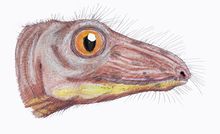
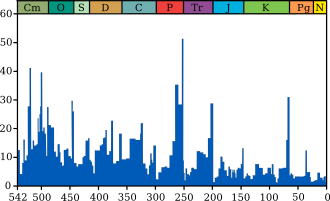
وقد يكون التغير المناخي أو تغير النباتات أو المنافسة البيئية أو كلها مجتمعة من أسباب فناء معظم السينودونتات الكبيرة ( المنتمية لترافيرسودونتيدا ) و ديسينودونتا (من عائلة كانيمايريداي ) خلال الحقبة رايتيان ـ قبل حدوث انقراض العصر الطباشيري-الثلاثي الذي قضى على جميع الأركوصورات الكبيرة. وما بقي من مندمجات الأقواس الوسطى فكانت صغيرة الأحجام بين حجم الزاحفة سرو إلى ما يشبه الغرير ذو ثدي "ريبينوماموس".
خلال العصر الثلاثي (الترياسي) و الطباشيري كانت السينودونتات التي بقيت من الغير ثدييات صغيرة الجسم مثل "تريديلودون " . ولم تكبر حيوانات السنودونتات عن القطة . وكانت معظم حيوانات العصر الثلاثي والطباشيري من السينودونتات من آكلات الأعشاب ، وبعض منها كان آكل اللحوم. ظهرت عائلة تريثيليدونتيدا أول مرة قرب نهاية العصر الثلاثي. وكانت آكلة اللحوم وظلت حتى الجوراسي الأوسط . وأما الآخرين ،التريتيلوندونتيداي ، فقد ظهرت أول مرة أيضا مع ظهور ال "تريثيليدونت " ، ولكنها كانت آكلة للحوم. لا نجد احفورات لتلك المجموعة بعد العصر الطباشيري المبكر ، فقد انقرضت . واعتقد أن ديسينودونت انقرض أيضا قرب نهاية العصر الثلاثي ولكن عثر على احفورات منها مما يشير أنها قد عاشت. تشير الأحفورات الجديدة إلى وجودها في صخور العصر الطباشيري في قارة غوندوانا الكبيرة القديمة .
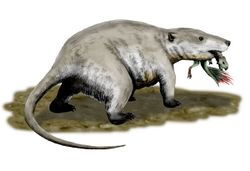
يعيش في وقتنا الحاضر 5.500 نوع من السينابسيدات والتي نعرفها بأنها الثدييات. وهي تشمل ما يعيش في المياه (الحيتان) و الخفافيش التي تطير و أكبر الحيوانات التي وجدت على الأرض (الحوت الأزرق). كما أن الإنسان هو أحد السينابسيدات . أكثر أنواع مندمجات الأقواس غرابة هو رتبة الكظاميات ، فبينما معظم الثدييات تلد ، فإن الكظاميات تبيض وترضع صغارها ، ونعرف منها نوعين يعيشان في شرق أستراليا ، وهما خلد الماء و آكل النمل الشائك.
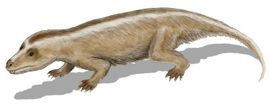
الثدييات القديمة التي عاشت خلال العصر الترياسي والعصر الجوراسي ومن ينتمي إليها من رتب قريبة تتميز بمعدل تمثيل غذائي عالي. ويعتقد أنها كانت تعيش على أكل الحشرات التي كانت تأكل منها كميات كبيرة . وقد ساعدها في هضم الطعام عملية المضغ ونشأة أسنان لها تخصصية مثل الضروس. وتطورت أطرافها لتكون تحتها وليست على جانبيها ، ترفعها عن الارض وتتيح لها امكانية التنقس أثناء الجري. وهذا ما يساعدها في الحصول على ما تحتاجه من غذاء.
العلاقات
يبين التفرع أسفله تفرع مندمجات الأقواس وهو التفرع الأكثر قبولا لدى العلماء وينتهي بنشأة الثدييات Mammals التي كانت لها خصائص تحميها من الانقراض ، وعاشت حتى الآن بعد أن مرت بحدث انقراض العصر الطباشيري-الثلاثي قبل نحو 65 مليون سنة :[43][44]
- (تعني العلامة † حيوان منقرض).
| مندمجات الأقواس |
| |||||||||||||||||||||||||||||||||||||||||||||||||||||||||||||||||||||
Most uncertainty in the phylogeny of synapsids lies among the earliest members of the group, including forms traditionally placed within Pelycosauria. As one of the earliest phylogenetic analyses, Brinkman & Eberth (1983) placed the family Varanopidae with Caseasauria as the most basal offshoot of the synapsid lineage. Reisz (1986) removed Varanopidae from Caseasauria, placing it in a more derived position on the stem. While most analyses find Caseasauria to be the most basal synapsid clade, Benson's analysis (2012) placed a clade containing Ophiacodontidae and Varanopidae as the most basal synapsids, with Caseasauria occupying a more derived position. Benson attributed this revised phylogeny to the inclusion of postcranial characteristics, or features of the skeleton other than the skull, in his analysis. When only cranial or skull features were included, Caseasauria remained the most basal synapsid clade. Below is a cladogram modified from Benson's analysis (2012):[45]
|
| ||||||||||||||||||||||||||||||||||||||||||||||||||||||||||||||||||||||||||||||||||||||||||||||||||||||||||||||||||||||||||||||||||||||||||||||||||||||||||||||||||||||||||||||||||||||||||||||||||||||||||||||||||||||||||||||||||||||||||||||||||||||||||||||||||||||||||||||||||
However, more recent examination of the phylogeny of basal synapsids, incorporating newly described basal caseids and eothyridids,[46] returned Caseasauria to its position as the sister to all other synapsids. Brocklehurst et al. (2016)[46] demonstrated that many of the postcranial characters used by Benson (2012) to unite Caseasauria with Sphenacodontidae and Edaphosauridae were absent in the newly discovered postcranial material of eothyridids, and were therefore acquired convergently.
. . . . . . . . . . . . . . . . . . . . . . . . . . . . . . . . . . . . . . . . . . . . . . . . . . . . . . . . . . . . . . . . . . . . . . . . . . . . . . . . . . . . . . . . . . . . . . . . . . . . . . . . . . . . . . . . . . . . . . . . . . . . . . . . . . . . . . . . . . . . . . . . . . . . . . . . . . . . . . . . . . . . . . . .
انظر أيضاً
- Anapsid
- Diapsid
- Euryapsida
- Lists of synapsids
- Mammal classification
- List of prehistoric mammals
- Timeline of the evolutionary history of life
- Vertebrate paleontology
ملاحظات
- ^ باليونانية: συν- + ἁψίς (apsís, 'قوس') > *συναψίδης (synapsídes) "ذوات الأقواس الملتحمة"؛ المرادفة لـ theropsids (يونانية تعني "وحشية الوجه")
المراجع
- ^ Steen, Margaret C. (1934). "The amphibian fauna from the South Joggins. Nova Scotia". Journal of Zoology. 104 (3): 465–504. doi:10.1111/j.1096-3642.1934.tb01644.x.
- ^ David S. Berman (2013). "Diadectomorphs, amniotes or not?". New Mexico Museum of Natural History and Science Bulletin. 60: 22–35.
- ^ Klembara, Jozef; Hain, Miroslav; Ruta, Marcello; Berman, David S.; Pierce, Stephanie E.; Henrici, Amy C. (2019). "Inner ear morphology of diadectomorphs and seymouriamorphs (Tetrapoda) uncovered by high‐resolution x‐ray microcomputed tomography, and the origin of the amniote crown group". Palaeontology. 63: 131–154. doi:10.1111/pala.12448.
- ^ Brocklehurst, N. (2021). "The first age of reptiles? Comparing reptile and synapsid diversity, and the influence of lagerstätten, during the Carboniferous and early Permian". Frontiers in Ecology and Evolution. 9: 669765. doi:10.3389/fevo.2021.669765.
- ^ Seeley, Harry Govier (1895). "Researches on the structure, organisation, and classification of the fossil reptilia. Part X. On the complete skeleton of an anomodont reptile (Aristodesmus rutimeyeri, Wiedersheim), from the Bunter sandstone of Reihen, near Basel, giving new evidence of the relation of the Anomodontia to the Monotremata". Proceedings of the Royal Society of London. 59: 167–169. doi:10.1098/rspl.1895.0070.
- ^ Laurin and Reisz 2007.
- ^ أ ب Romer, A.S. & Parsons, T.S. (1985): The Vertebrate Body. (6th ed.) Saunders, Philadelphia.
- ^ أ ب ت Carroll 1988: 397.
- ^ أ ب Benton 2005: 122.
- ^ New proto-mammal fossil sheds light on evolution of earliest mammals - The University of Chicago Medicine Archived 2017-09-04 at the Wayback Machine
- ^ Angielczyk, Kenneth D. (2009). "Dimetrodon is not a dinosaur: Using tree thinking to understand the ancient relatives of mammals and their evolution". Evolution: Education and Outreach. 2 (2): 257–271. doi:10.1007/s12052-009-0117-4. S2CID 24110810.
- ^ Modesto, S.P.; Anderson, J.S. (2004). "The phylogenetic definition of Reptilia". Systematic Biology. 53 (5): 815–821. doi:10.1080/10635150490503026. PMID 15545258.
- ^ Benton, Michael J. (2005). Vertebrate Paleontology, 3rd ed. Oxford: Blackwell Science Ltd. ISBN 0-632-05637-1. p. 120.
- ^ Hopson, James A. (1987). "The Mammal-Like Reptiles: A Study of Transitional Fossils". The American Biology Teacher. 49 (1): 16–26. doi:10.2307/4448410. JSTOR 4448410.
- ^ Hildebran, M.; Goslow, G. (2001). Analysis of Vertebrate Structure (5th ed.). New York: John Wiley & Sons. ISBN 0-471-29505-1.
- ^ Vickaryous, Matthew K. & Sire, Jean-Yves (2009). "The integumentary skeleton of tetrapods: origin, evolution, and development". Journal of Anatomy. 214 (4): 441–464. doi:10.1111/j.1469-7580.2008.01043.x. PMC 2736118. PMID 19422424.
- ^ Ford, David P.; Benson, Roger B. J. (May 2019). Mannion, Philip (ed.). "A redescription of Orovenator mayorum (Sauropsida, Diapsida) using high‐resolution μ CT , and the consequences for early amniote phylogeny". Papers in Palaeontology (in الإنجليزية). 5 (2): 197–239. doi:10.1002/spp2.1236. ISSN 2056-2802.
- ^ Ford, David P.; Benson, Roger B. J. (January 2020). "The phylogeny of early amniotes and the affinities of Parareptilia and Varanopidae". Nature Ecology & Evolution (in الإنجليزية). 4 (1): 57–65. doi:10.1038/s41559-019-1047-3. ISSN 2397-334X.
- ^ Maddin, Hillary C.; Mann, Arjan; Hebert, Brian (January 2020). "Varanopid from the Carboniferous of Nova Scotia reveals evidence of parental care in amniotes". Nature Ecology & Evolution (in الإنجليزية). 4 (1): 50–56. doi:10.1038/s41559-019-1030-z. ISSN 2397-334X.
- ^ Benoit, Julien; Ford, David; Miyamae, Juri; Ruf, Irina (2021). "Can maxillary canal morphology inform varanopid phylogenetic affinities?". Acta Palaeontologica Polonica (in الإنجليزية). 66. doi:10.4202/app.00816.2020. ISSN 0567-7920.
- ^ Reisz, Robert (1975). "Pennsylvanian Pelycosaurs from Linton, Ohio and Nýřany, Czechoslovakia". Journal of Paleontology. 49 (3): 522–527. ISSN 0022-3360.
- ^ Niedźwiedzki, G.; Bojanowski, M. (2012). "A supposed eupelycosaur body impression from the early Permian of the Intra-Sudetic basin, Poland". Ichnos. 19 (3): 150–155. doi:10.1080/10420940.2012.702549. S2CID 129567176.
- ^ Carroll, R.L. (1969). "Problems of the origin of reptiles". Biological Reviews. 44 (3): 393–432. doi:10.1111/j.1469-185X.1969.tb01218.x. S2CID 84302993.
- ^ Spindler, Frederik; Werneburg, Ralf; Schneider, Joerg W.; Luthardt, Ludwig; Annacker, Volker; Rößler, Ronny (2018). "First arboreal 'pelycosaurs' (Synapsida: Varanopidae) from the early Permian Chemnitz Fossil Lagerstätte, SE Germany, with a review of varanopid phylogeny". PalZ. 92 (2): 315–364. doi:10.1007/s12542-018-0405-9. S2CID 133846070.
- ^ Kardong, K.V. (2002). Vertebrates: Comparative Anatomy, Function, Evolution (3rd ed.). Boston: McGraw-Hill. ISBN 0-07-112235-4.
- ^ Kemp, T.S. (2006). "The origin and early radiation of the therapsid mammal-like reptiles: A palaeobiological hypothesis". Journal of Evolutionary Biology. 19 (4): 1231–1247. doi:10.1111/j.1420-9101.2005.01076.x. PMID 16780524. S2CID 3184629.
- ^ Ji, Q.; Luo, Z-X; Yuan, Chong-Xi; Tabrum, Alan R. (February 2006). "A swimming mammaliaform from the middle Jurassic and ecomorphological diversification of early mammals". Science. 311 (5764): 1123–7. Bibcode:2006Sci...311.1123J. doi:10.1126/science.1123026. PMID 16497926. S2CID 46067702.
See also the news item at "Jurassic "beaver" found; rewrites history of mammals". National Geographic. Feb 2006. - ^ Meng, Qing-Jin; Grossnickle, David M.; Di, Liu; Zhang, Yu-Guang; Neander, April I.; Ji, Qiang; Luo, Zhe-Xi (2017). "New gliding mammaliaforms from the Jurassic". Nature. 548 (7667): 291–296. Bibcode:2017Natur.548..291M. doi:10.1038/nature23476. PMID 28792929. S2CID 205259206.
- ^ أ ب ت ث Ruben, J.A.; Jones, T.D. (2000). "Selective factors associated with the origin of fur and feathers". Am. Zool. 40 (4): 585–596. doi:10.1093/icb/40.4.585.
- ^ Gaare, Megan (7 October 2014). "An Early Nocturnal Ancestor". Field Museum of Natural History. Retrieved 11 March 2022.
- ^ Bajdek, Piotr; Qvarnström, Martin; Owocki, Krzysztof; Sulej, Tomasz; Sennikov, Andrey G.; Golubev, Valeriy K.; Niedźwiedzki, Grzegorz (2016). "Microbiota and food residues including possible evidence of pre-mammalian hair in Upper Permian coprolites from Russia". Lethaia. 49 (4): 455–477. doi:10.1111/let.12156.
- ^ أ ب ت Oftedal, Olav T. (2002-07-01). "The mammary gland and its origin during synapsid evolution". Journal of Mammary Gland Biology and Neoplasia. 7 (3): 225–252. doi:10.1023/a:1022896515287. ISSN 1083-3021. PMID 12751889. S2CID 25806501.
- ^ أ ب Oftedal, O.T. (2012-03-01). "The evolution of milk secretion and its ancient origins". Animal. 6 (3): 355–368. doi:10.1017/S1751731111001935. ISSN 1751-732X. PMID 22436214.
- ^ أ ب Oftedal, Olav T. (2002-07-01). "The origin of lactation as a water source for parchment-shelled eggs". Journal of Mammary Gland Biology and Neoplasia. 7 (3): 253–266. doi:10.1023/A:1022848632125. ISSN 1083-3021. PMID 12751890. S2CID 8319185.
- ^ "Monotremes and marsupials". www.life.umd.edu. Retrieved 2018-08-23.
- ^ "Life History and Ecology of the Monotremata". www.ucmp.berkeley.edu. Retrieved 2018-08-23.
- ^ Luo, Zhe-Xi; Meng, Qing-Jin; Grossnickle, David M.; Di, Liu; Neander, April I.; Zhang, Yu-Guang; Ji, Qiang (2017). "New evidence for mammaliaform ear evolution and feeding adaptation in a Jurassic ecosystem". Nature. 548 (7667): 326–329. Bibcode:2017Natur.548..326L. doi:10.1038/nature23483. PMID 28792934. S2CID 4463476.
- ^ Meng, J.; Hu, Y.-M.; Wang, Y.-Q.; Wang, X.-L.; Li, C.-K. (2007). "Corrigendum: A Mesozoic gliding mammal from northeastern China". Nature. 446 (7131): 102. Bibcode:2007Natur.446Q.102M. doi:10.1038/nature05639.
- ^ Gaetano, L.C.; Rougier, G.W. (2011). "New materials of Argentoconodon fariasorum (Mammaliaformes, Triconodontidae) from the Jurassic of Argentina and its bearing on triconodont phylogeny". Journal of Vertebrate Paleontology. 31 (4): 829–843. doi:10.1080/02724634.2011.589877. hdl:11336/68497. S2CID 85069761.
- ^ (2000) "Small marsupial glider from the Paleocene of Itaboraí, Brazil" in Meeting of the Society of Vertebrate Paleontology. 20.
- ^ Lambert 2001: 68-69.
- ^ Naturwissenschaften. 98 (12). doi:10.1007/s00114-011-0856-2.
{{cite journal}}: Missing or empty|title=(help); Unknown parameter|الأخير1=ignored (help); Unknown parameter|الأخير2=ignored (help); Unknown parameter|الأخير3=ignored (help); Unknown parameter|الأخير4=ignored (help); Unknown parameter|الأول1=ignored (help); Unknown parameter|الأول2=ignored (help); Unknown parameter|الأول3=ignored (help); Unknown parameter|الأول4=ignored (help); Unknown parameter|السنة=ignored (help); Unknown parameter|الصفحات=ignored (help); Unknown parameter|العنوان=ignored (help) - ^
{{cite web}}: Empty citation (help) - ^ Forerunners of Mammals. Bloomington: Indiana University Press. 2011. pp. 3–30.
{{cite book}}: Cite has empty unknown parameters:|lay-date=,|subscription=,|nopp=,|last-author-amp=,|name-list-format=,|lay-source=,|registration=, and|lay-summary=(help) - ^ Benson, R.J. (2012). "Interrelationships of basal synapsids: cranial and postcranial morphological partitions suggest different topologies". Journal of Systematic Palaeontology. 10 (4): 601–624. doi:10.1080/14772019.2011.631042. S2CID 84706899.
- ^ أ ب Neil Brocklehurst; Robert Reisz; Vincent Fernandez; Jörg Fröbisch (2016). "A Re-Description of 'Mycterosaurus' smithae, an Early Permian Eothyridid, and Its Impact on the Phylogeny of Pelycosaurian-Grade Synapsids". PLOS ONE. 11 (6): e0156810. Bibcode:2016PLoSO..1156810B. doi:10.1371/journal.pone.0156810. PMC 4917111. PMID 27333277.
وصلات خارجية
- Synapsida - Pelycosauria - at Palaeos
- Transitional Vertebrate Fossils - includes description of important transitional genera in the evolutionary sequence linking primitive synapsids to mammals
- Articles containing Greek-language text
- CS1 errors: unsupported parameter
- CS1 errors: missing title
- CS1 errors: empty citation
- Short description is different from Wikidata
- Articles with hatnote templates targeting a nonexistent page
- Automatic taxobox cleanup
- مندمجات الأقواس
- بلايكوصورات
- تفرعات حيوانية غير مصنفة
- ثيرابسيدات
- Tetrapod unranked clades
- كائنات باقية ظهرت خلال فترة الپنسلڤاني

